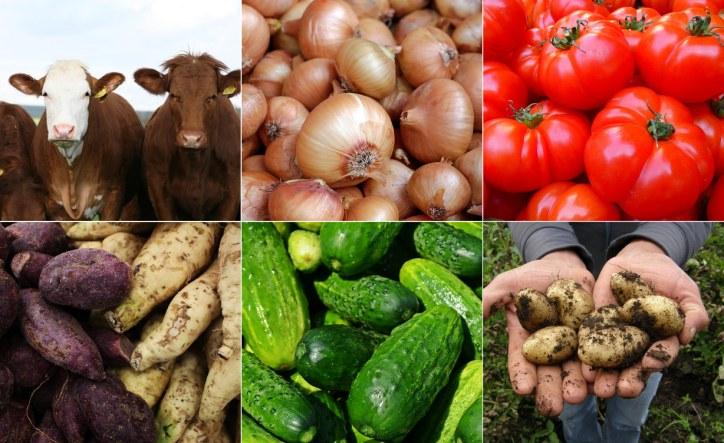Africa-Press – Rwanda. Despite efforts by regional governments to achieve food security through elaborate plans and policies, the region remains food deficient. Kenya, Uganda, South Sudan, Ethiopia, Rwanda, and Somalia are all currently facing different levels of food deficiencies due to drought, insufficient rainfall, conflict, locust invasion, and the aftershocks of Covid-19, which have slowed down agricultural activities.
Food security According to the East Africa Food Security Outlook from June to January 2022 as published by the Relief Web, food assistance needs will remain high and above average in Somalia, southern and southeastern Ethiopia, and northern and eastern Kenya through at least early 2022.
These issues came up at the annual Africa Green Revolution Forum (AGRF) summit held on September 7 to 10 in Nairobi. The summit focused on accelerating progress in the development of resilient food systems in the region and the continent.
The Tigray region in Ethiopia will face severe food shortages due to the almost one year of conflict, while in the eastern Horn and northern Uganda many households have already lost food and incomes due to the impact of irregular rainfall on crop and livestock production in early-to-mid 2021.
Economic shocks are expected to exacerbate the severity of acute food insecurity in parts of the region, especially in Ethiopia, South Sudan and Sudan. The Covid pandemic also continues to affect food insecurity, especially among urban households in Kenya, Uganda, and Rwanda and refugees in Uganda.
In Kenya, the government has put more than 12 out of the 47 counties on red alert with government figures showing that about 400,000 people are facing starvation in the coastal region alone. Some 12 counties are on drought alert, according to the National Drought Management Authority.
According to the United Nations Office for the Co-ordination of Humanitarian Affairs (OCHA), more than 2.1 million people in the arid and semi-arid lands of Kenya are severely food insecure, following two consecutive seasons of poor rains, which have hampered crop production.
Limited access to food — aggravated by the loss of income and closure of markets in some counties due to Covid-19 — has left over 532,000 children under five years and 93,300 pregnant or lactating women in urgent need of treatment for acute malnutrition.
From January to July, humanitarian organisations in Kenya reached 491,000 people with critical assistance, including food and agricultural inputs, treatment for acute malnutrition, water, sanitation and hygiene, as well as health, education and protection services. Food systems
Harry Kimtai, the Principal Secretary in the Ministry of Agriculture, Livestock, Fisheries and Irrigation, said that investments in agriculture will only be sustainable with proper regulations and policies, which the national government is trying to do after devolving the agricultural sector to the counties.
“The government has put in place programmes to sustain our food systems by involving processing and storage. The biggest challenge is post-harvest losses due to poor storage infrastructure,” Mr Kimtai told a virtual food summit that discussed ways to ensure sustainable food systems.
In Sudan, for instance, the Famine Early Warning Systems Network (FEWS NET) estimates that poor macroeconomic conditions as well as protracted conflict in parts of Darfur, Kordofan, and Red Sea states and widespread seasonal floods are pushing food assistance needs nearly 50-60 percent above the five-year average.
In Rwanda, the country’s Meteorology Agency warned that parts of Eastern and Southern provinces are likely to face unusual dry spells similar to those that befell the country in 2016, 2010 and 1996. The agency announced the outlook on August 27, while releasing the September to December rainfall seasonal forecast.
“In 2016, there was less rainfall, which triggered unusual dry spells and we might have similar worries this season,” said Anthony Twahirwa, division manager of Weather Climate Services and Applications at Meteo Rwanda.
In 2016, more than 47,300 households with over 230,000 people suffered from the drought that hit the country, with Kayonza, Nyagatare and Kirehe districts in Eastern Province most affected.
Aimable Gahigi, Director-General of the Rwanda Meteorological Agency, said the country has been facing changes in climate and weather events due to human activities that are polluting the atmosphere. Floods, landslides, extreme heat events, and drought events are increasing and posing threats to the country. “We have been facing delays in rainfall onset and when rains end. This affects sectors such as agriculture,” he said.
According to the AGRF summary for the summit, since 2014 droughts have cost the region $372 billion. Also, the locust outbreak in Ethiopia and Somalia between 2019/2020 destroyed over 356,000 tonnes of cereals and almost 1.5 million hectares of crop and pasture in Ethiopia.
Farming The former Prime Minister of Ethiopia and AGRF Board Chair, Hailemariam Dessalegn, said that a lot needs to be done to increase food production and make the region food-sufficient through inclusive agriculture.
“We must work collaboratively to ensure that policy, technology and finances respond to the needs of our farmers. This is critical to achieving zero hunger across the continent and around the globe,” he said.
In Tanzania, a recent report by the National Bureau of Statistics said that most farmers in the country have not embraced irrigation. Only 5.2 percent or 411,108 farmers out of a sample 7.8 million practised irrigation farming in the country.
Although this is an increase compared with a decade ago, the development still signals slow implementation of irrigation and agriculture policies. Agriculture Minister Adolf Mkenda acknowledged during the launch that productivity in the sector is still a major hurdle that limits farmers’ earnings and their contribution to the national economy.
He said the contribution of the crop sub-sector to the nation’s GDP is still low at 15.4 percent, while in total the agriculture sector contribution is also not satisfactory at 26.9 percent. Governments have been trying to encourage the participation of the youth in agriculture, who make up the bulk of the active population in the region.






